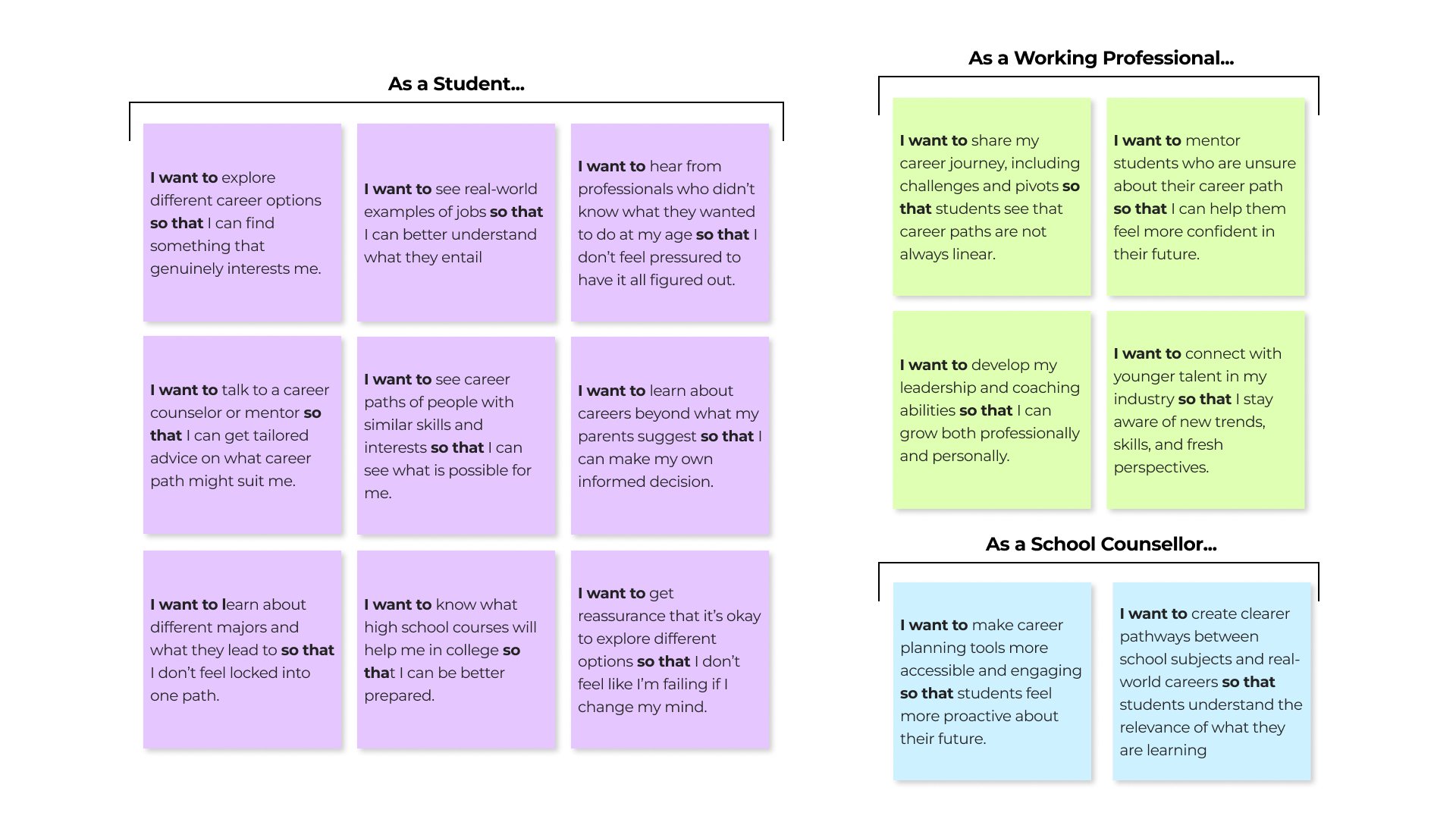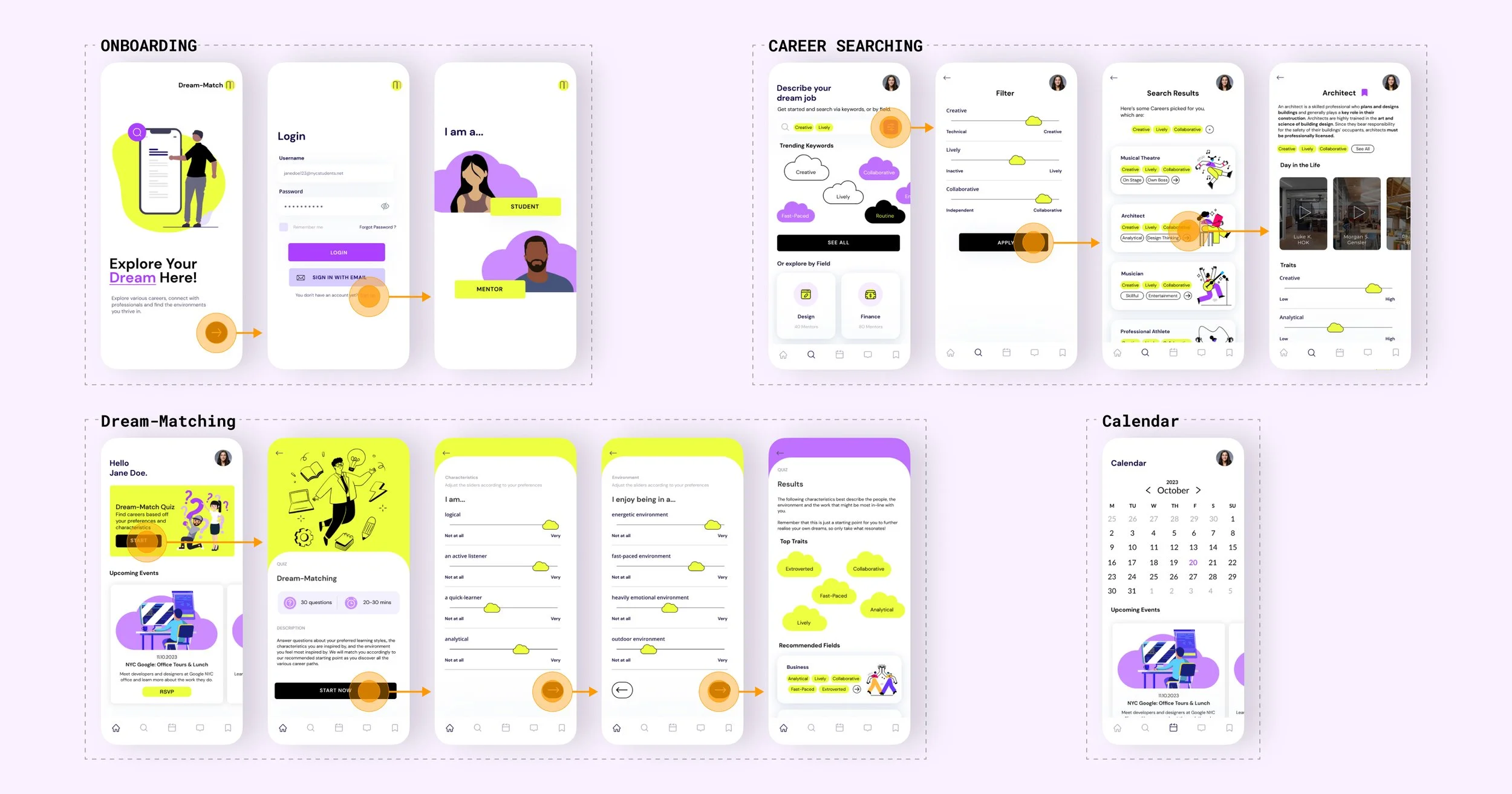
Exploring career options through mentorship for high school students.
Dream-Match
Individual Project
Duration: 10 Weeks
There is a disconnect between high school students expectation of a career and what the reality of the careers day-to-day is. There is a lack of fostering and mentorship for students to better understand how their diverse interests, and personalities can play a role in careers selection
The Challenge
There is a need to assist students in broaden their perspectives, while also helping them focus on a career best fit for their personality and the environment in which they thrive.
The Opportunity
Introducing, Dream-Match.
The Solution
Dream-Match is a platform that helps high school students explore potential career paths by connecting them with mentors of their choice. The database of careers are all categorised by traits, and ranked by working professional mentors. This assists students to recognise which environments best fit their personality and preferences.
Problem Discovery
Growing up, I dreamt of becoming an astrophysicist, inspired by astronauts like Kalpana Chawla.
Growing up, I dreamt of becoming an astrophysicist, inspired by astronauts like Kalpana Chawla. Somewhere along the way, that dream faded. Instead, I opted for the familiar path of computer science—a choice driven by practicality rather than passion. This shift made me question why so many of us abandon our childhood dreams when it comes to choosing a career.
Secondary Research
Why is there a disconnect between our childhood dream jobs, and what our careers become professionally?
Primary Research
To better understand my problem space I talked with different stakeholders. This included Working Professionals, Public School Staff, and High School Students.
“My job is nothing like I expected it to be, although I thought I knew what I wanted, I never understood it fully until I finished my undergrad and started working. I don’t 100% regret it, but my personality doesn’t fit in at my job and I do think that plays a large role in my stress.”
- Software Engineer
“Students often ask, ‘Why do I need to learn this?’ I want to help them see how what they’re learning in the classroom connects to the real-world, so they feel motivated and also prepared for their future”
- High School English Teacher
“What if I pick the wrong career and get stuck doing something I hate? […] I feel like I’m supposed to know what I want to do, but I honestly have no clue”
- Highschool Junior
From the primary research, I started building insights through user stories to understand different stakeholders priorities.
Defining the User: User Stories and Journeys
Synthesis
Research Takeaways
Mentorship
Seeing a variety of professionals in various careers expands the students knowledge of the career spectrum.
Building Skills Early
Learning a professionals skillset and tools earlier, can assist students understand if they might enjoy day-to-day tasks.
Work Environment
Understanding various professions work and environment culture is insightful to know if your personality and character traits match it.
Forming Concepts
Rather than thinking of careers in subjects, we should think of them as a spectrum of characteristics.
In pulling insights together I realized there was a new narrative of how we could start to speak and think about careers.
Opportunity Statement
We need a solution that focuses on assisting students broaden their perspectives on careers, while also giving them mentorship for them focus on a career best fit for their personality and the environment in which they thrive
User Testing
Concept Flow Testing: 1-on-1 Mentorship v.s Trait Based Career Searching
Concept A is imagining a mentor-mentee communication platform. NYC Public Schools would be able to contact Dream-Match, who would provide an in-person survey asking students about what environment they envision themselves in. Dream-Match would then be in charge of matching each student to a mentor.
A
The flow focuses on assisting high schoolers to discover careers fitting to the environment they thrive in & the type of people they want to be around. They can then choose their own mentors from all types of backgrounds.
B
Highschool students would like to have a personalized mentorship experience but they place priority in exploration; learning about a career and what it entails rather than focusing on the end goal.
By combining Concept A and B, I started focusing on How might we assist highschool students in Career Exploration which focuses on who they enjoy working with and in what environment rather than the task itself?
Style Guide
A brand built on energising colours that excite Gen-Z, modern yet readable typography, scholastic vector imagery, and fun Microinteractions for engagement
WALK THROUGH FLOWS
Student Onboarding
1
Any student is able to create an account with their DOE email. A specific email given to every New York City public school student when they are enrolled in school. Using this email verifies student status. Mentors go through an application process which includes a security background check as well.
Searching Careers
2
Through the search feature, students can explore careers through the keyword tag system, or they can look by field. This allows for students to choose whether they already had a specific field in mind or want to freely take a look. The keywords are arranged in trending order, to show popular tags. Once students choose their keywords, they are able to adjust the scale of their traits. This allows them to customise their searches even further.
The search result will list wide range of careers which fit these traits from all fields, unless filtered. Each career comes with a description, and a scale of its traits. Students can also watch short workday vlogs, and message available Dream-Match mentors.
Pain Points Addressed: Mentorship, Exposure to Careers
Dream-Matching
3
Dream-Matching is a quiz available to all new users. The quiz goes through a series of characteristic questions, asking the student to best describe their personality or what environment they enjoy. This allows for a starting point in researching the wide array of careers available.
Pain Points Addressed: Mentorship, Exposure to Careers
Beyond the App
4
Dream-Match extends beyond the app in multiple forms. While it started as a workshop idea, Dream-Match also partners with Universities and companies to host tours and workshops. This allows students to see workspaces, and allows offices and universities to find potential new talent. As part of the experience, Dream-Match also gifts branded school items at these events.
Pain Points Addressed: Learning new skills, understanding different work environments
Dream-Labs
5
Dream-Labs is an extension of Dream-Match which hosts workshops, leads research in learning techniques, and has a library of online courses led by the mentors of Dream-Match.
Pain Points Addressed: Learning new skills, Mentorship
With more time and resources, I would…
All the concept tests were ran with School Teachers ranging from middle school teachers to high school. I would have liked to also talked with high school students and get their insights during concept testing.
Test with Students
I would have liked to do another round of concept testing specifically given the distinct changes that were made from the initial testing. I would be interested in learning more about the reactions to the branding and visual schemes used.
2. Test Last Prototype
3. Initiate Partnerships
The strategy design component relies heavily on partnerships. If we can speak with New York Public School admins, it will give a better understanding of how these partnerships might work, and if there is any interest at all.
















